

(1) Facebook. Rio + 20: La Terre malade de ses trois poumons verts. A la veille du Rio+20, quelles solutions proposent les acteurs politiques de ces régions pour inverser la tendance?

A eux trois, ils représentent 80% des forêts tropicales de la Terre. Les bassins forestiers de l’Amazonie, du Mékong et du Congo sont de véritables poumons pour notre planète, mais les abattages d’arbres abusifs qu’ils subissent mettent en grande difficulté à la fois la biodiversité et les populations locales qui se nourrissent, se protègent et se soignent grâce à eux. Une coopération «Sud Sud» Pour parler d’une seule et même voix, la République du Congo a non seulement été chargée de représenter l’Afrique lors du Rio+20, mais aussi de réunir les pays des deux autres bassins, l’Amazonie et le Bornéo-Mékong, autour des thématiques majeures de l’économie verte et du développement durable. Quel est l'état de la biodiversité ? Le Monde.fr | • Mis à jour le | Par Audrey Garric "La biodiversité n'a jamais été dans un si mauvais état et elle continue à décliner.
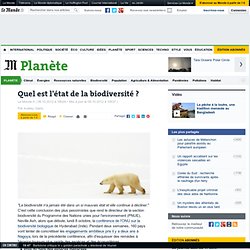
" C'est cette conclusion des plus pessimistes que rend le directeur de la section biodiversité du Programme des Nations unies pour l'environnement (PNUE), Neville Ash, alors que débute, lundi 8 octobre, la conférence de l'ONU sur la biodiversité biologique de Hyderabad (Inde). Science as a “Candle in the Darkness” Die Zeit: 2025 - die Welt vor dem ökologischen Kollaps.
Anzeige Die Zeit läuft uns davon: Laut einer neuen Studie droht bereits im nächsten Jahrzehnt der Zusammenbruch des ökologischen Gleichgewichts.
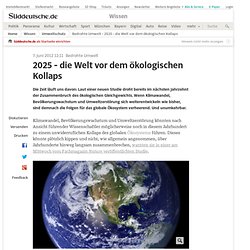
Wenn Klimawandel, Bevölkerungswachstum und Umweltzerstörung sich weiterentwickeln wie bisher, sind demnach die Folgen für das globale Ökosystem verheerend. Und unumkehrbar. The Climate Crisis.
Can the Government Control the Weather? The Answer Surprised Me Too. A string of extreme weather events, such as a polar vortex in the US and mass flooding across the UK, have led some to question if this strange weather came as the result of some sort of government experiment into artificial weather creation.

While we might wish to scoff at conspiracy theories about ‘fake snow‘, or government induced floods to steal land, it turns out the weather making experiments themselves are not actually bunkum, and have in fact been tied to disasters past. No, I couldn’t believe it either so I did some reading. The New Scientist and the BBC carried articles in 2001, linking rain making experiments by the UK government, to a devastating flood that killed 35 people. The New Scientist report reads: Extreme Jan- Feb and Climate Change. 2014 weather and climate change (video)
Dr.

Jeff Masters from Weather Underground drops some science on those who think they can conclude that the planet isn't warming because "it's so cold this winter! " Interestingly, cold isn't the only abnormal weather pattern for North-America right now. There's also historic warm temperatures in Alaska, and the deepest drought in decades across the west... You really have to see the graphics and listen to the interview - it's great - but the general idea is that sometimes the Jet Stream slows down and shifts South, allowing very cold arctic air to come down over most of Canada and the US. This is a regional phenomenon, more like shifting heat around on the planet to unusual places, rather than actually cooling it.
Another factor: Cold waves used to be more frequent, and now that we're not used to them, they seem worse. Global Warming 101. Global Warming or Global Governance? (Full Length) Climate Change: Vital Signs of the Planet. The ARIES approach. Overview With growing interest in using ecosystem services for decision making, demand has grown for systematic methods and tools to quantify ecosystem service values.
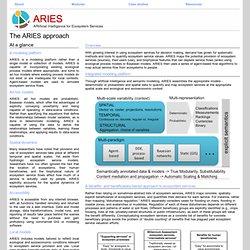
ARIES maps the potential provision of ecosystem services (sources), their users (use), and biophysical features that can deplete service flows (sinks) using ecological process models or Bayesian models. ARIES then uses a series of agent-based flow algorithms to map actual service flow from ecosystems to people. Integrated modeling platform Through artificial intelligence and semantic modeling, ARIES assembles the appropriate models - deterministic or probabilistic and spatial data to quantify and map ecosystem services at the appropriate spatial scale and ecological and socioeconomic context. Steady Increase in Climate Related Natural Disasters - Climate Change Weather Blog. Steady Increase in Climate Related Natural Disasters November 15, 2013; 3:38 PM The incidence of natural disasters worldwide has steadily increased, especially since the 1970's, according to a report from the New England Journal of Medicine.
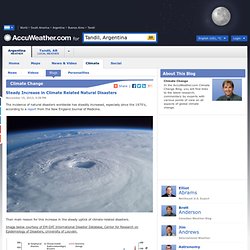
Then main reason for this increase in the steady uptick of climate-related disasters. Image below courtesy of EM-DAT International Disaster Database, Center for Research on Epidemiology of Disasters, University of Louvain. Since 1990, natural disasters have affected about 217 million people every year. Surging Seas. Polar vortex. Animation: North and South Poles melting away. 5 Things Hurricane Sandy Changed for Good. Some people and places may never be the same since Hurricane Sandy hit the northern Atlantic Coast on Oct. 29, 2012.
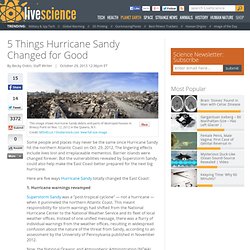
The lingering effects include lives lost and irreplaceable mementos. Barrier islands were changed forever. But the vulnerabilities revealed by Superstorm Sandy could also help make the East Coast better prepared for the next big hurricane. News Desk: Hurricane Irene and Global Warming: A Glimpse of the Future? Nowadays, whenever there’s an Irene-like event—a huge storm, a terrible flood, a killer heat wave—the question is raised: was this caused by global warming?

The very frequency with which this question is being asked these days should make people take notice, but the answer that comes back is usually squishy enough to allow them to forget about the issue until the next disaster occurs, at which point the process starts all over again. The problem here, as several commentators have pointed out this weekend, is that the question being posed is not the question we should be asking.
The standard answer to the question “Was Irene (or the recent flooding along the Missouri River, or the current record-breaking Texas drought, or [choose your own favorite example]) caused by global warming?” Is: No one event can be definitively attributed to climate change (though in some cases, you can get pretty close). Meanwhile, rising temperatures make other risks worse as well.